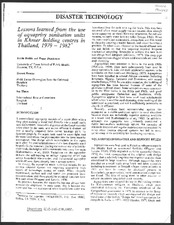| dc.description.abstract | A conventional aquaprivy consists of a squat plate with a drop-pipe making a water seal directly into a small septic tank underneath. Anaerobic digestion of the faecal material takes place in the tank, and excess effluent is drained off into a nearby seep away (also called ‘soakage pit’). To function properly, the septic tank must be water-tight, and the water seal where the pipe empties into the tank must be maintained. The sludge which accumulates in the septic tank after the partial breakdown of the faecal matter must be periodically removed. During the normal use of a familysized tank, desludging will be necessary only every few years (Kalbermatten et al., 1980). Variations on the aquaprivy include the self-topping or sullage aquaprivy which can accept household waste-water, and the sewered aquaprivy where effluent flows directly into a sewage system. In theory, the aqua privy meets technical criteria for an excreta disposal system not requiring excessively high inputs of technology, money or water. When properly maintained, surface soil and water are protected from contamination, and there should be minimal nuisance from flies and odour (Wagner and Lanoix, 1958). In practice, however, the aquaprivy has not always been successfully employed. In most cases, this is because the water seal was not maintained when insufficient water was introduced into the tank on a regular basis. This may have occurred where water supply was not located close enough to the aquaprivy, or where there was reluctance, for cultural reasons, to carry water into the toilet (Iwugo, 1981). When the water seal is not maintained, mosquitoes and flies breed in the privy creating a health hazard, and odour becomes a problem. In other cases, disposal of the liquid effluent into the soil failed, so that the seepaway required frequent mechanical emptying. Strategies to achieve this task have not always been adequate (McGarry, 1977). The drop-pipe may also become clogged where solid materials are used for anal cleansing. Aquaprivies were invented in India in the early 1900s (Williams, 1924). They have subsequently been used in many countries in Asia and their application appears to be successful on that continent (McGarry, 1977). Aquaprivies have been installed in several African countries including Botswana, Nigeria, Tanzania and Zimbabwe, with mixed results (Iwugo, 1981). In one African nation, the building of aquaprivies has been banned because of some of the problems outlined above. Some aquaprivies were constructed in the West Indies in the 1950s and 1960s, with good public acceptance (Sebastian and Buchanan, 1965). Aquaprivies appear to have been used most satisfactorily where water is used for anal cleansing, daily washing of the toilet bowl is practiced, and soil is sufficiently permeable to absorb all effluent.
Recently, authors have recommended against the aquaprivy as a viable sanitation option in most situations because there are technically superior systems- available at a lower cost (Kalbermatten et alf 1980). In addition, although the aquaprivy was previously considered a viable intermediate technology option, the necessity of relatively frequent and regular maintenance not required by many other excreta disposal systems has led to some questioning of its suitability for developing countries. | en |


